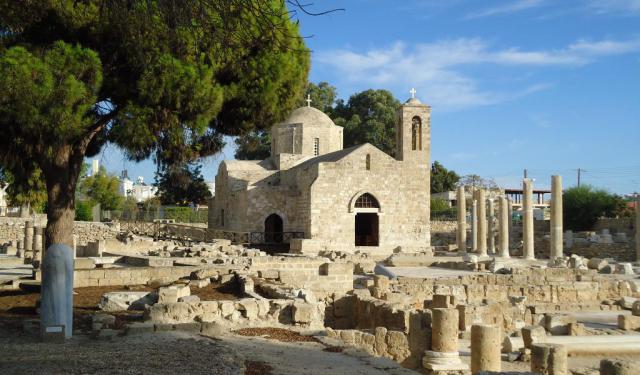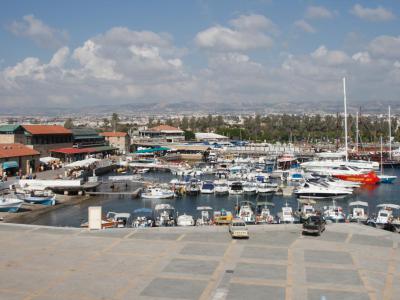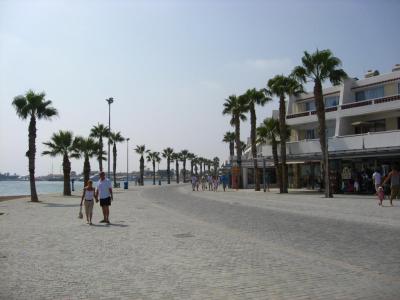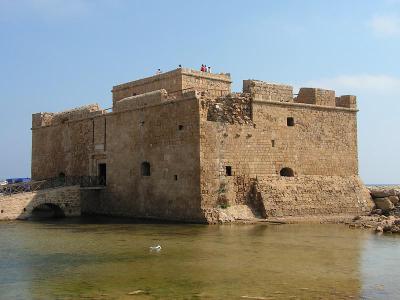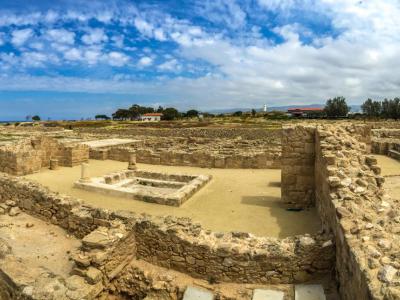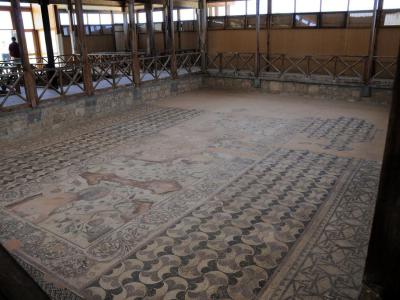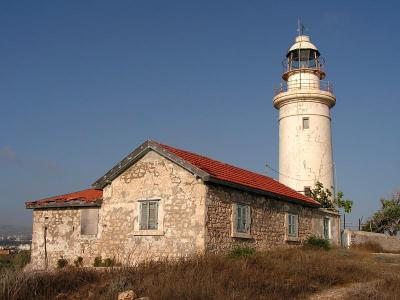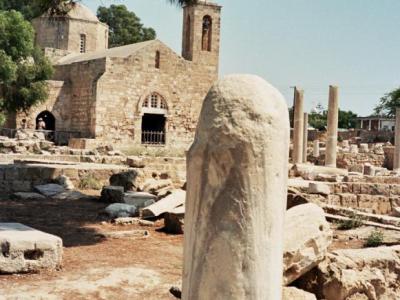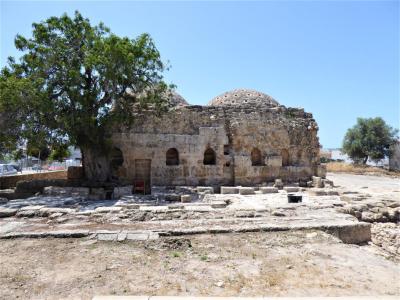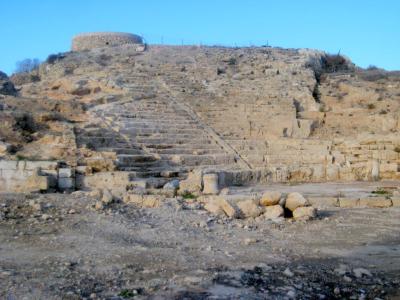Paphos Introduction Walking Tour (Self Guided), Paphos
For most people, the mesmerizing town of Paphos on the southwestern coast of Cyprus is all about sun, sand, and sea. However, alongside its beachy vibes, this seaside resort is home to a swag of important historical tourist attractions that contributed to Paphos being anointed European Capital of Culture in 2017.
Indeed, as a UNESCO World Heritage-listed city, Paphos is steeped in both mythological lore and archaeological significance. According to legend, it was here that Aphrodite, the Greek goddess of love and beauty, emerged from the sea foam.
The name "Paphos" itself is said to be derived from the mythological founder of the city, Paphos, the son of Pygmalion and Galatea whose "milk-white" ivory image was brought to life by the goddess.
The area of Old Paphos (now known as Kouklia) was a focal point of Aphrodite's worship, becoming the foremost site for her adoration in the ancient world.
Nicocles, the last King of Old Paphos moved the city to its present location, near the harbor, at the end of the 4th century BC. Between the 2nd century BC and the 4th century AD, New Paphos was the capital of Cyprus.
In biblical history, it was here that Saul of Tarsus became known as Paul the Apostle. The Church of Agia Kyriaki and Saint Paul's Pillar tell the tales of early Christianity in the region.
Over the ages, Paphos has seen periods of decline, especially after the rise of Nicosia. Yet, its fortune shifted in the 20th century, thanks to investments in tourism, infrastructure, and an international airport.
During the height of summer, the town gets clogged with visitors. This may be a good time to head out of the downtown area for some sightseeing and explore places along the coast.
Paphos Harbour and Port offer a glimpse into the city's maritime history and provide a picturesque setting for a leisurely stroll. Paphos Castle stands as a stoic sentinel, a testament to the city's tumultuous past, having served as a fortress, prison, and a backdrop for various historical events. Nearby, the Nea Paphos Archaeological Park houses remarkable remnants of a once-thriving ancient city, including the House of Dionysus, adorned with exquisite mosaics that vividly depict mythological scenes.
In Paphos, every street corner seems to whisper stories of bygone eras. Whether you're an avid history buff or simply seeking a picturesque getaway, Paphos welcomes you with open arms, ready to unveil its timeless treasures. So, wait no more! Come and explore this enchanting city and discover its magic that has captivated travelers for centuries!
Indeed, as a UNESCO World Heritage-listed city, Paphos is steeped in both mythological lore and archaeological significance. According to legend, it was here that Aphrodite, the Greek goddess of love and beauty, emerged from the sea foam.
The name "Paphos" itself is said to be derived from the mythological founder of the city, Paphos, the son of Pygmalion and Galatea whose "milk-white" ivory image was brought to life by the goddess.
The area of Old Paphos (now known as Kouklia) was a focal point of Aphrodite's worship, becoming the foremost site for her adoration in the ancient world.
Nicocles, the last King of Old Paphos moved the city to its present location, near the harbor, at the end of the 4th century BC. Between the 2nd century BC and the 4th century AD, New Paphos was the capital of Cyprus.
In biblical history, it was here that Saul of Tarsus became known as Paul the Apostle. The Church of Agia Kyriaki and Saint Paul's Pillar tell the tales of early Christianity in the region.
Over the ages, Paphos has seen periods of decline, especially after the rise of Nicosia. Yet, its fortune shifted in the 20th century, thanks to investments in tourism, infrastructure, and an international airport.
During the height of summer, the town gets clogged with visitors. This may be a good time to head out of the downtown area for some sightseeing and explore places along the coast.
Paphos Harbour and Port offer a glimpse into the city's maritime history and provide a picturesque setting for a leisurely stroll. Paphos Castle stands as a stoic sentinel, a testament to the city's tumultuous past, having served as a fortress, prison, and a backdrop for various historical events. Nearby, the Nea Paphos Archaeological Park houses remarkable remnants of a once-thriving ancient city, including the House of Dionysus, adorned with exquisite mosaics that vividly depict mythological scenes.
In Paphos, every street corner seems to whisper stories of bygone eras. Whether you're an avid history buff or simply seeking a picturesque getaway, Paphos welcomes you with open arms, ready to unveil its timeless treasures. So, wait no more! Come and explore this enchanting city and discover its magic that has captivated travelers for centuries!
How it works: Download the app "GPSmyCity: Walks in 1K+ Cities" from Apple App Store or Google Play Store to your mobile phone or tablet. The app turns your mobile device into a personal tour guide and its built-in GPS navigation functions guide you from one tour stop to next. The app works offline, so no data plan is needed when traveling abroad.
Paphos Introduction Walking Tour Map
Guide Name: Paphos Introduction Walking Tour
Guide Location: Cyprus » Paphos (See other walking tours in Paphos)
Guide Type: Self-guided Walking Tour (Sightseeing)
# of Attractions: 10
Tour Duration: 2 Hour(s)
Travel Distance: 4.1 Km or 2.5 Miles
Author: DanaOffice
Sight(s) Featured in This Guide:
Guide Location: Cyprus » Paphos (See other walking tours in Paphos)
Guide Type: Self-guided Walking Tour (Sightseeing)
# of Attractions: 10
Tour Duration: 2 Hour(s)
Travel Distance: 4.1 Km or 2.5 Miles
Author: DanaOffice
Sight(s) Featured in This Guide:
- Paphos Harbour and Port
- Paphos Promenade
- Paphos Castle
- Nea Paphos Archaeological Park
- The House of Dionysus
- Paphos Lighthouse
- Church of Agia Kyriaki and Saint Paul's Pillar
- Medieval - Frankish Baths
- Hellenistic-Roman Theatre
- Kings Avenue Mall
1) Paphos Harbour and Port (must see)
Paphos Harbour and Port is a bustling and lively destination that offers a rich tapestry of experiences for both locals and tourists. This charming harbor and port are known for their unique blend of culture, history, dining, and entertainment.
Paphos Harbour boasts a relatively shallow depth, with waters typically ranging between 2 to 4 meters. What sets this harbor apart is its accessibility. Visitors can explore it on foot, creating an intimate and pedestrian-friendly environment.
The harbor area is lined with an array of restaurants, cafes, and bars, making it a food lover's paradise. You can savor a diverse range of dishes, from traditional Cypriot cuisine to international delights, all while enjoying picturesque views of the sea. The blend of flavors and atmospheres is a testament to the cosmopolitan character of the place.
Amid the cozy eateries and lively establishments, you'll also find clothing and souvenir shops. These offer the perfect opportunity to pick up mementos and keepsakes, allowing you to remember your visit to this vibrant place.
The proximity to the beach is another highlight of Paphos Harbour. Tourists and locals alike are drawn to the sandy shores, where they can soak up the Mediterranean sun, swim in the clear blue waters, and take leisurely strolls along the coastline.
As the sun sets, Paphos Harbour transitions into a hub of nightlife and entertainment. With hotels within walking distance, the area is filled with life, and the sidewalks become a lively hub of activity. Locals and visitors can be seen mingling and enjoying traditional fish taverns, bars, and cafes. This is the perfect time to savor delicious food and drinks, often accompanied by live music and a festive atmosphere.
Paphos Harbour boasts a relatively shallow depth, with waters typically ranging between 2 to 4 meters. What sets this harbor apart is its accessibility. Visitors can explore it on foot, creating an intimate and pedestrian-friendly environment.
The harbor area is lined with an array of restaurants, cafes, and bars, making it a food lover's paradise. You can savor a diverse range of dishes, from traditional Cypriot cuisine to international delights, all while enjoying picturesque views of the sea. The blend of flavors and atmospheres is a testament to the cosmopolitan character of the place.
Amid the cozy eateries and lively establishments, you'll also find clothing and souvenir shops. These offer the perfect opportunity to pick up mementos and keepsakes, allowing you to remember your visit to this vibrant place.
The proximity to the beach is another highlight of Paphos Harbour. Tourists and locals alike are drawn to the sandy shores, where they can soak up the Mediterranean sun, swim in the clear blue waters, and take leisurely strolls along the coastline.
As the sun sets, Paphos Harbour transitions into a hub of nightlife and entertainment. With hotels within walking distance, the area is filled with life, and the sidewalks become a lively hub of activity. Locals and visitors can be seen mingling and enjoying traditional fish taverns, bars, and cafes. This is the perfect time to savor delicious food and drinks, often accompanied by live music and a festive atmosphere.
2) Paphos Promenade
The Paphos Promenade is a quintessential Mediterranean gem that invites you to experience the picturesque beauty of Paphos. This recently extended boardwalk stretches for approximately five kilometers along the central coastline, providing locals and visitors alike with a delightful seafront stroll.
If you're seeking a leisurely seafront stroll, the Paphos Promenade has you covered. This charming pathway meanders along the central Paphos coastline, offering you the chance to immerse yourself in the soothing sounds of the sea and the refreshing sea breezes.
The promenade's southern section begins at the historic Paphos Fort and extends down to the beautiful Louis Phaethon Beach Resort. This part of the trail takes you past some of the central Kato Paphos beaches, providing ample opportunities to enjoy the sandy shores and sparkling waters. Cafés along the way offer stunning sea views and the perfect spots to relax and sip your favorite beverage.
While the southern section is a delightful beachside walk, the northern half of the boardwalk promises even more intriguing adventures. Starting at Paphos Harbor with its iconic fort, the northern route leads all the way to the renowned Tombs of the Kings, a historic archaeological site.
Souvenir shops and local vendors offer you a chance to take home a piece of Cyprus. Whether you're looking for traditional crafts or mementos of your trip, the promenade has you covered.
If you're seeking a leisurely seafront stroll, the Paphos Promenade has you covered. This charming pathway meanders along the central Paphos coastline, offering you the chance to immerse yourself in the soothing sounds of the sea and the refreshing sea breezes.
The promenade's southern section begins at the historic Paphos Fort and extends down to the beautiful Louis Phaethon Beach Resort. This part of the trail takes you past some of the central Kato Paphos beaches, providing ample opportunities to enjoy the sandy shores and sparkling waters. Cafés along the way offer stunning sea views and the perfect spots to relax and sip your favorite beverage.
While the southern section is a delightful beachside walk, the northern half of the boardwalk promises even more intriguing adventures. Starting at Paphos Harbor with its iconic fort, the northern route leads all the way to the renowned Tombs of the Kings, a historic archaeological site.
Souvenir shops and local vendors offer you a chance to take home a piece of Cyprus. Whether you're looking for traditional crafts or mementos of your trip, the promenade has you covered.
3) Paphos Castle (must see)
Originally constructed as a Byzantine fortress, the Paphos Castle's primary purpose was to safeguard the nearby port. Over time, the fortress underwent various additions and renovations, mirroring the evolution of the island's dominion.
At the heart of the castle stands the Western Frankish Tower, adorned with Venetian modifications that were meticulously restored by the Ottomans in 1592. An inscription above the castle's entrance proudly acknowledges this renovation, orchestrated by the Turkish governor of Cyprus, Ahmet Pasha. This event is etched into history on a white marble slab above the entrance.
The castle saw extensive rebuilding and expansion under the Lusignans in the 13th century, including the construction of the renowned "Genoese Towers." These two towers, located at the port's entrance, played a pivotal role in defending against Genoese naval forces in 1373. They were also instrumental during a battle against the Mamluks in 1426. Unfortunately, these towers were severely damaged by a powerful earthquake in 1491, and their ruins remain as a testament to their once vital role.
The Venetians, who exerted their control over the region, maintained and enhanced the castle further, adding their own distinctive features.
The main structure of the castle consists of a large rectangular tower. The ground floor housed small rooms, while the two substantial chambers on either side served as prisons and barracks during the Ottoman era. The castle roof boasts a small square tower, offering stunning views of the surrounding area. Twelve ramparts, encircling the perimeter, once held an equivalent number of cannons, a reflection of the castle's military importance during the Turkish occupation.
With the arrival of the British in 1878, the castle's military role diminished, and it became a salt depot until 1935 when it gained recognition as an ancient monument. Since then, it has become an iconic symbol of Paphos. In the years that followed, the castle underwent several repairs to maintain its historic significance.
To truly appreciate the splendor of Paphos Castle, visitors can cross over the bridged moat and ascend the fort. The reward for this brief journey is unparalleled views that stretch across the Mediterranean Sea and the vibrant harbor below. While you may spend only a short time within the castle's walls, the €2.50 entry fee is more than justified by the awe-inspiring vistas it offers.
At the heart of the castle stands the Western Frankish Tower, adorned with Venetian modifications that were meticulously restored by the Ottomans in 1592. An inscription above the castle's entrance proudly acknowledges this renovation, orchestrated by the Turkish governor of Cyprus, Ahmet Pasha. This event is etched into history on a white marble slab above the entrance.
The castle saw extensive rebuilding and expansion under the Lusignans in the 13th century, including the construction of the renowned "Genoese Towers." These two towers, located at the port's entrance, played a pivotal role in defending against Genoese naval forces in 1373. They were also instrumental during a battle against the Mamluks in 1426. Unfortunately, these towers were severely damaged by a powerful earthquake in 1491, and their ruins remain as a testament to their once vital role.
The Venetians, who exerted their control over the region, maintained and enhanced the castle further, adding their own distinctive features.
The main structure of the castle consists of a large rectangular tower. The ground floor housed small rooms, while the two substantial chambers on either side served as prisons and barracks during the Ottoman era. The castle roof boasts a small square tower, offering stunning views of the surrounding area. Twelve ramparts, encircling the perimeter, once held an equivalent number of cannons, a reflection of the castle's military importance during the Turkish occupation.
With the arrival of the British in 1878, the castle's military role diminished, and it became a salt depot until 1935 when it gained recognition as an ancient monument. Since then, it has become an iconic symbol of Paphos. In the years that followed, the castle underwent several repairs to maintain its historic significance.
To truly appreciate the splendor of Paphos Castle, visitors can cross over the bridged moat and ascend the fort. The reward for this brief journey is unparalleled views that stretch across the Mediterranean Sea and the vibrant harbor below. While you may spend only a short time within the castle's walls, the €2.50 entry fee is more than justified by the awe-inspiring vistas it offers.
4) Nea Paphos Archaeological Park (must see)
Paphos Archaeological Park, also known as Kato Pafos Archaeological Park, encompasses a significant portion of the ancient Greek and Roman city of Paphos and continues to be a site of ongoing excavation, offering a remarkable journey through time.
Within the park's boundaries, visitors can explore a diverse range of sites and monuments that span from prehistoric periods to the Middle Ages. Among the most prominent and well-preserved discoveries are four grand Roman villas: the House of Dionysos, the House of Aion, the House of Theseus, and the House of Orpheus. These villas boast exquisite mosaic floors, with the Orpheus mosaic being a particularly breathtaking example of ancient artistry.
The archaeological explorations have also revealed an agora (a central public space), an asklipieion (a healing temple), a basilica, an odeion (a small theater), a Hellenistic-Roman theater, and a necropolis recognized as the "Tombs of the Kings."
Nea Paphos, situated within the Paphos Archaeological Park, forms an integral part of the Paphos archaeological complex inscribed on the UNESCO World Heritage List. This recognition was bestowed upon the complex in 1980 in acknowledgment of its exceptional mosaics, ancient remnants, and historical religious significance.
Historically, Nea Paphos is believed to have been established by Nicocles, the final king of Paphos, towards the close of the 4th century BC. It subsequently became the island's capital at the beginning of the 2nd century BC during the Hellenistic period under the rule of the Ptolemies, supplanting Salamis as the capital.
In 1965, archaeological excavations were initiated under the guidance of Prof. Kazimierz Michałowski, conducted by the Polish Centre of Mediterranean Archaeology at the University of Warsaw. The excavations uncovered remarkable finds, including marble statues of Asclepius and Artemis, both significant deities worshipped in the city. Additionally, a treasure trove of silver coins from the reigns of Philip III of Macedon and Alexander the Great was brought to light.
Within the park's boundaries, visitors can explore a diverse range of sites and monuments that span from prehistoric periods to the Middle Ages. Among the most prominent and well-preserved discoveries are four grand Roman villas: the House of Dionysos, the House of Aion, the House of Theseus, and the House of Orpheus. These villas boast exquisite mosaic floors, with the Orpheus mosaic being a particularly breathtaking example of ancient artistry.
The archaeological explorations have also revealed an agora (a central public space), an asklipieion (a healing temple), a basilica, an odeion (a small theater), a Hellenistic-Roman theater, and a necropolis recognized as the "Tombs of the Kings."
Nea Paphos, situated within the Paphos Archaeological Park, forms an integral part of the Paphos archaeological complex inscribed on the UNESCO World Heritage List. This recognition was bestowed upon the complex in 1980 in acknowledgment of its exceptional mosaics, ancient remnants, and historical religious significance.
Historically, Nea Paphos is believed to have been established by Nicocles, the final king of Paphos, towards the close of the 4th century BC. It subsequently became the island's capital at the beginning of the 2nd century BC during the Hellenistic period under the rule of the Ptolemies, supplanting Salamis as the capital.
In 1965, archaeological excavations were initiated under the guidance of Prof. Kazimierz Michałowski, conducted by the Polish Centre of Mediterranean Archaeology at the University of Warsaw. The excavations uncovered remarkable finds, including marble statues of Asclepius and Artemis, both significant deities worshipped in the city. Additionally, a treasure trove of silver coins from the reigns of Philip III of Macedon and Alexander the Great was brought to light.
5) The House of Dionysus (must see)
The House of Dionysos, a prominent feature of the Paphos Archaeological Park in Cyprus, is one of four Roman villas renowned for their exquisite floor mosaics. These Roman villas are collectively known as the Mosaic Houses, each adorned with intricately crafted mosaics that provide a fascinating glimpse into the art and culture of the period.
The House of Dionysos is celebrated for its remarkable floor mosaics that grace its interior. These mosaics, meticulously composed of limestone tiles, are believed to have been created during the second and third centuries AD. Intriguingly, these intricate artworks remained hidden from view until 1962 when a local farmer stumbled upon them.
This extraordinary villa, which occupies a total area of 2000 square meters, is named after the Greek god Dionysos. The god Dionysos is a recurring theme in many of the mosaics found within the villa. These mosaics depict scenes from mythology, history, and hunting, and they offer valuable insights into the cultural and artistic influences of the time.
The House of Dionysos features a well-planned architectural layout. Its rooms are organized around a central courtyard, known as an atrium, which served as the heart of the villa. This central space was not only aesthetically pleasing but also functioned as a hub for various activities within the house.
The villa's construction dates back to the end of the 2nd century AD, representing a significant period of Roman rule in Cyprus. However, the villa's decline and eventual abandonment were prompted by a series of devastating earthquakes in the 4th century AD. These natural disasters led to the villa's structural damage and its eventual abandonment.
Beneath the House of Dionysos, evidence of an earlier villa from the 3rd century BC has been discovered. This villa is particularly notable for its Hellenistic pebble mosaic that portrays the mythical sea-monster Scylla. This ancient mosaic has been preserved in its original location, offering a unique opportunity to observe the historical and artistic transition between different periods.
The House of Dionysos, along with the other Mosaic Houses in the area, stands as a testament to the opulence and cultural sophistication of the Roman era in Paphos. The well-preserved mosaics are a vivid representation of the artistic achievements and interests of the time, allowing modern visitors to step back in history and appreciate the enduring beauty of these ancient works of art.
The House of Dionysos is celebrated for its remarkable floor mosaics that grace its interior. These mosaics, meticulously composed of limestone tiles, are believed to have been created during the second and third centuries AD. Intriguingly, these intricate artworks remained hidden from view until 1962 when a local farmer stumbled upon them.
This extraordinary villa, which occupies a total area of 2000 square meters, is named after the Greek god Dionysos. The god Dionysos is a recurring theme in many of the mosaics found within the villa. These mosaics depict scenes from mythology, history, and hunting, and they offer valuable insights into the cultural and artistic influences of the time.
The House of Dionysos features a well-planned architectural layout. Its rooms are organized around a central courtyard, known as an atrium, which served as the heart of the villa. This central space was not only aesthetically pleasing but also functioned as a hub for various activities within the house.
The villa's construction dates back to the end of the 2nd century AD, representing a significant period of Roman rule in Cyprus. However, the villa's decline and eventual abandonment were prompted by a series of devastating earthquakes in the 4th century AD. These natural disasters led to the villa's structural damage and its eventual abandonment.
Beneath the House of Dionysos, evidence of an earlier villa from the 3rd century BC has been discovered. This villa is particularly notable for its Hellenistic pebble mosaic that portrays the mythical sea-monster Scylla. This ancient mosaic has been preserved in its original location, offering a unique opportunity to observe the historical and artistic transition between different periods.
The House of Dionysos, along with the other Mosaic Houses in the area, stands as a testament to the opulence and cultural sophistication of the Roman era in Paphos. The well-preserved mosaics are a vivid representation of the artistic achievements and interests of the time, allowing modern visitors to step back in history and appreciate the enduring beauty of these ancient works of art.
6) Paphos Lighthouse
Paphos Lighthouse, a steadfast guardian of Cyprus's southwestern coast, stands as both a maritime beacon and a historical testament. Situated on Paphos Point, a picturesque peninsula extending into the Mediterranean Sea, this iconic lighthouse has been a silent sentinel since its construction in 1888, during Cyprus's British colonial era.
In the late 19th century, when Cyprus was a pivotal military base protecting the sea route from the Suez Canal to the British colonies, Paphos Lighthouse took on a vital role. It became a reassuring landfall marker, guiding ships on their approach to the bustling Paphos harbor from distant Britain. The gleam of its light served as a welcoming embrace for sailors navigating the Mediterranean waters.
This lighthouse, with its timeless grace, showcases a 20-meter high masonry tower adorned with a pristine whitewashed exterior. Its elegant simplicity evokes a sense of dignity and purpose. A single gallery encircles the lantern, and this solitary figure stands encircled by a modest compound that includes the keeper's dwelling and various outbuildings.
Paphos Lighthouse, with its lantern positioned at a focal height of 36 meters above the sea, emits a brilliant and reassuring light that stretches far across the waves. Sailors can glimpse this reassuring radiance from a distance of 17 nautical miles, an essential guide for those traversing the Mediterranean waters. Its signature is a long flash of white light that renews hope every fifteen seconds.
In the late 19th century, when Cyprus was a pivotal military base protecting the sea route from the Suez Canal to the British colonies, Paphos Lighthouse took on a vital role. It became a reassuring landfall marker, guiding ships on their approach to the bustling Paphos harbor from distant Britain. The gleam of its light served as a welcoming embrace for sailors navigating the Mediterranean waters.
This lighthouse, with its timeless grace, showcases a 20-meter high masonry tower adorned with a pristine whitewashed exterior. Its elegant simplicity evokes a sense of dignity and purpose. A single gallery encircles the lantern, and this solitary figure stands encircled by a modest compound that includes the keeper's dwelling and various outbuildings.
Paphos Lighthouse, with its lantern positioned at a focal height of 36 meters above the sea, emits a brilliant and reassuring light that stretches far across the waves. Sailors can glimpse this reassuring radiance from a distance of 17 nautical miles, an essential guide for those traversing the Mediterranean waters. Its signature is a long flash of white light that renews hope every fifteen seconds.
7) Church of Agia Kyriaki and Saint Paul's Pillar
In the heart of Kato Paphos, where the whispers of history echo through time, you'll find Saint Paul's Pillar. This sacred site is not merely a pillar but a beacon illuminating the early Christian heritage of the island and the arduous journey taken by the early Christian pioneers to spread their faith.
Built in the 13th century, the Church of Panayia Chrysopolitissa, also known as 'Our Lady of the Golden City' or Ayia Kyriaki, stands on the hallowed ground where the early Christians laid the foundation for the faith that would shape the destiny of Cyprus. This church emerged upon the ruins of an early Byzantine basilica, signifying a continuous thread of religious significance across centuries.
Saint Paul's Pillar, which resides nearby, is the epicenter of a transformative moment in early Christian history. It was here, after enduring a flogging, that Saint Paul, the indefatigable apostle, achieved a remarkable feat. He managed to convert the Roman governor Sergius Paulus to Christianity, an event that left an indelible mark on the religious landscape of Cyprus.
The church was originally a magnificent seven-aisled basilica, but over time, it underwent a transformation, reducing its structure to five aisles. Beneath its arching walls, the basilica's mosaic-laden floor told stories of beauty, devotion, and spirituality. Some fragments of these exquisite mosaics still grace the sacred site, offering a glimpse into the artistic and religious fervor of the past.
Built in the 13th century, the Church of Panayia Chrysopolitissa, also known as 'Our Lady of the Golden City' or Ayia Kyriaki, stands on the hallowed ground where the early Christians laid the foundation for the faith that would shape the destiny of Cyprus. This church emerged upon the ruins of an early Byzantine basilica, signifying a continuous thread of religious significance across centuries.
Saint Paul's Pillar, which resides nearby, is the epicenter of a transformative moment in early Christian history. It was here, after enduring a flogging, that Saint Paul, the indefatigable apostle, achieved a remarkable feat. He managed to convert the Roman governor Sergius Paulus to Christianity, an event that left an indelible mark on the religious landscape of Cyprus.
The church was originally a magnificent seven-aisled basilica, but over time, it underwent a transformation, reducing its structure to five aisles. Beneath its arching walls, the basilica's mosaic-laden floor told stories of beauty, devotion, and spirituality. Some fragments of these exquisite mosaics still grace the sacred site, offering a glimpse into the artistic and religious fervor of the past.
8) Medieval - Frankish Baths
The Medieval - Frankish Baths harken back to the ancient world when communal baths were not just places for personal cleansing but also served as social hubs. In Paphos, these baths offer a captivating insight into the historical customs of personal hygiene and leisure.
The Medieval - Frankish Baths of Paphos were constructed during the Frankish period, somewhere between the late 14th and early 15th centuries. This historical epoch represents a fascinating fusion of architectural styles and cultural practices, and these baths are a tangible testament to this convergence. Nestled within the same complex as the early Christian Basilica of Ayias Kyriakis (Chrisopolitissa), the baths are a microcosm of the layered history that characterizes Paphos.
The architecture of the bath complex is nothing short of remarkable. The central structure is meticulously crafted from stone, a testament to the craftsmanship of the era. The baths are further adorned with lateral extensions, showcasing the site's expansion and adaptation over time. With the arrival of the Ottoman period, the original semi-circular vaulted roofs were replaced with elegant domes, infusing an element of Ottoman architectural influence into the structure.
The Medieval - Frankish Baths of Paphos were constructed during the Frankish period, somewhere between the late 14th and early 15th centuries. This historical epoch represents a fascinating fusion of architectural styles and cultural practices, and these baths are a tangible testament to this convergence. Nestled within the same complex as the early Christian Basilica of Ayias Kyriakis (Chrisopolitissa), the baths are a microcosm of the layered history that characterizes Paphos.
The architecture of the bath complex is nothing short of remarkable. The central structure is meticulously crafted from stone, a testament to the craftsmanship of the era. The baths are further adorned with lateral extensions, showcasing the site's expansion and adaptation over time. With the arrival of the Ottoman period, the original semi-circular vaulted roofs were replaced with elegant domes, infusing an element of Ottoman architectural influence into the structure.
9) Hellenistic-Roman Theatre
The Hellenistic-Roman Theatre, which once echoed with the voices of actors and the applause of spectators, tells the story of a cultural heritage that spans centuries.
Built around 300 BC by the Ptolemies of Alexandria, this theatre found its home on the southern slope of a hill, on the northeast side of the ancient walled city of Nea Paphos. It stood as a testament to the enduring love for the performing arts during Greek and Roman times, and its existence continued until the late 4th century AD.
The theatre underwent several transformations throughout its history, with at least five major phases of building and renovation. These phases reflect the evolving nature of performances, from the early Greek traditions to the opulence of the Roman period, as well as responses to damages caused by earthquakes.
At the zenith of its glory, during the reign of the Roman Antonine emperors in the mid-second century AD, the theatre's stage building was adorned with a majestic marble facade. With a remarkable width of 90 meters and a cavea that could accommodate over 8,000 spectators at an impressive angle of 26.5 degrees, this theatre was a true marvel of ancient engineering and architecture.
However, by the end of the third century AD, likely in the aftermath of a devastating earthquake in 365 AD, the theatre was abandoned. Much of its stonework was repurposed and carried away for use in other construction projects throughout the town. For centuries, the theatre lay in silent repose, a relic of bygone times.
Yet, in the 12th and 13th centuries AD, the theatre experienced a renaissance of sorts. The bustling activity around the Paphos harbour, now a crucial economic hub for Crusaders en route to the Holy Land, brought renewed life to this ancient site.
Built around 300 BC by the Ptolemies of Alexandria, this theatre found its home on the southern slope of a hill, on the northeast side of the ancient walled city of Nea Paphos. It stood as a testament to the enduring love for the performing arts during Greek and Roman times, and its existence continued until the late 4th century AD.
The theatre underwent several transformations throughout its history, with at least five major phases of building and renovation. These phases reflect the evolving nature of performances, from the early Greek traditions to the opulence of the Roman period, as well as responses to damages caused by earthquakes.
At the zenith of its glory, during the reign of the Roman Antonine emperors in the mid-second century AD, the theatre's stage building was adorned with a majestic marble facade. With a remarkable width of 90 meters and a cavea that could accommodate over 8,000 spectators at an impressive angle of 26.5 degrees, this theatre was a true marvel of ancient engineering and architecture.
However, by the end of the third century AD, likely in the aftermath of a devastating earthquake in 365 AD, the theatre was abandoned. Much of its stonework was repurposed and carried away for use in other construction projects throughout the town. For centuries, the theatre lay in silent repose, a relic of bygone times.
Yet, in the 12th and 13th centuries AD, the theatre experienced a renaissance of sorts. The bustling activity around the Paphos harbour, now a crucial economic hub for Crusaders en route to the Holy Land, brought renewed life to this ancient site.
10) Kings Avenue Mall
Nestled in the heart of central Paphos, Kings Avenue Mall is a retail paradise where shopping desires and leisure dreams are transformed into a vibrant reality. This modern and impressive shopping mall stands as a testament to Cyprus's contemporary shopping culture and welcomes local residents and tourists alike, making it the epitome of a shopping and entertainment destination.
Kings Avenue Mall stands as the pinnacle of modernity, boasting a captivating architectural design and a sophisticated interior layout. This mall is where you'll discover an extensive array of shops, services, and entertainment options, all under one roof.
Kings Avenue Mall takes pride in housing an array of international fashion brands, high-fashion boutiques, specialty stores, and more. You'll find something for everyone, with shops catering to men, women, and children, as well as lifestyle, sports apparel, electronics, cosmetics, and more. The mall is your go-to destination for fashion, accessories, and everything in between.
Beyond shopping, Kings Avenue Mall is a haven for culinary delights. World-renowned restaurant chains and cafes beckon you to enjoy a gastronomic journey that complements your shopping adventures.
Kings Avenue Mall understands that shopping knows no bounds, and it operates on an extended tourist-friendly schedule, seven days a week. This ensures that visitors have the luxury of time to explore, shop, dine, and immerse themselves in the vibrant atmosphere.
Kings Avenue Mall stands as the pinnacle of modernity, boasting a captivating architectural design and a sophisticated interior layout. This mall is where you'll discover an extensive array of shops, services, and entertainment options, all under one roof.
Kings Avenue Mall takes pride in housing an array of international fashion brands, high-fashion boutiques, specialty stores, and more. You'll find something for everyone, with shops catering to men, women, and children, as well as lifestyle, sports apparel, electronics, cosmetics, and more. The mall is your go-to destination for fashion, accessories, and everything in between.
Beyond shopping, Kings Avenue Mall is a haven for culinary delights. World-renowned restaurant chains and cafes beckon you to enjoy a gastronomic journey that complements your shopping adventures.
Kings Avenue Mall understands that shopping knows no bounds, and it operates on an extended tourist-friendly schedule, seven days a week. This ensures that visitors have the luxury of time to explore, shop, dine, and immerse themselves in the vibrant atmosphere.
Walking Tours in Paphos, Cyprus
Create Your Own Walk in Paphos
Creating your own self-guided walk in Paphos is easy and fun. Choose the city attractions that you want to see and a walk route map will be created just for you. You can even set your hotel as the start point of the walk.
Paphos Archaeological Park Walking Tour
Paphos is divided into two parts. Kato Paphos, the area near the harbor, is where all the archaeological sites are located, while Ktima (Old Town) is where you'll find the museums. The Archaeological Park of Kato Paphos has been included in the UNESCO World Heritage Sites list since 1980.
This park includes sites and monuments from the 4th century BC to the Middle Ages, while most remains... view more
Tour Duration: 1 Hour(s)
Travel Distance: 2.0 Km or 1.2 Miles
This park includes sites and monuments from the 4th century BC to the Middle Ages, while most remains... view more
Tour Duration: 1 Hour(s)
Travel Distance: 2.0 Km or 1.2 Miles
The Most Popular Cities
/ view all
